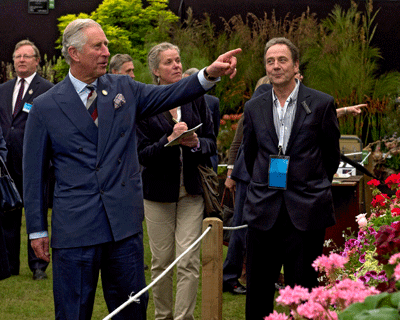Growing plants named after Royalty
Chief Horticulturist Guy Barter explains how plants come to be named after Royalty
It is a truth universally acknowledged that King Charles III loves his gardening. But what many gardeners may not know is that there is a rich array of garden plants that have been named after King Charles – or more commonly, after his previous title of the Prince of Wales.
What does it take to bestow a royal name on a plant, you ask? First of all, it takes many years – at least 10 for woody plants like roses – to breed a new cultivar. Even spontaneous ‘chance finds’ (often mutations, which are the source of many new garden plants) take several years to bulk up and produce enough plants to go on sale.
On the occasion that something suitably ‘kingly’ is found, permission to apply a Royal name must be sought from the Civil Service office’s ‘Royal Names Team’.
Take your pick from small trees, roses, clematis, hostas or even annuals, all named after Charles or the Prince of Wales.
When it comes to commemoration, trees are always a popular choice. The only tree currently named after the Prince of Wales is an Amelanchier; a fantastic flowering tree that’s ideal for bringing height to small gardens. It was selected by Tom Watson and Dr Ed Hasselkuss in Wisconsin, USA around 1970.
The pair were apparently royalists, as they also named other Amelanchier after members of our current royal family such as Amelanchier canadensis ‘Prince William’.
Happily, a number of more readily available plants were also named after the King while he was Prince of Wales.
Clematis ‘Prince Charles’, which was bred in New Zealand in 1975 and introduced to the UK in 1986, has at least a dozen UK suppliers and even boasts an RHS Award of Garden Merit. At just 2.5m (8ft) tall, this viticella-type clematis is relatively easy to find a place for in the garden; looking dreamy scaling a fence or scrambling over shrubs such as roses.
Clematis ‘Prince Charles’ bears pale mauve blooms in late summer, each up to an impressive 10cm (4ins) across. He won’t become unruly either, as he is pruned back in late winter to a pair of strong
Juniperus horizontalis ‘Prince of Wales’ is an interesting choice available from two suppliers. This low-growing juniper was discovered in Alberta, Canada in 1931, but introduced to the UK (and no doubt named) in 1967. A tough, spreading plant with greyish foliage, this evergreen is great for groundcover, sprawling over rock gardens or tumbling from troughs.
Hosta ‘Prince of Wales’ (seven UK suppliers) was introduced in 2012 by the late Diana Grenfell of Applecourt Nursery in Hampshire. Reaching 90cm (3ft) in height and spread, its a large, handsome
Two other plants, which are currently elusive for UK gardeners, are Sempervivum ‘Prince Charles’ (introduced 1990) and a triumph-type tulip, Tulipa ‘Prince Charles’ (1952).
Some plants were named after previous Princes of Wales. Erica carnea ‘Prince of Wales’, for example, was named for Edward, the eldest son of King George V, who went on to be King Edward VIII. A hardy evergreen, the plant is sure to outlast its namesake’s brief reign.
Rosa ‘Prince Charles’, a Bourbon rose introduced in 1842, was presumably named for the future Edward VII, who became Prince of Wales in 1841. Nicknamed the ‘Playboy Prince’, he was popular, but also somewhat notorious; indulging in all of life’s excesses. Streaked with scarlet, this cherry-red rose certainly reflects some of the Prince’s passion and indulgence.
The rose originated from a chance cross on the French Indian ocean territory of Reunion between the Autumn Damask rose ‘Tous les Mois’ and the ‘Parson’s Pink’ China rose before 1818. Bourbon roses are fragrant and, for their time, long-flowering. They had their heyday in the Victorian era but are now much less commonly grown. However, Rosa ‘Prince Charles’ is still offered for sale and bears its crimson flowers on sturdy bushes up to 1.2m (4ft) tall and wide.
- Most of these plants can be sourced via the online RHS Plant Finder


